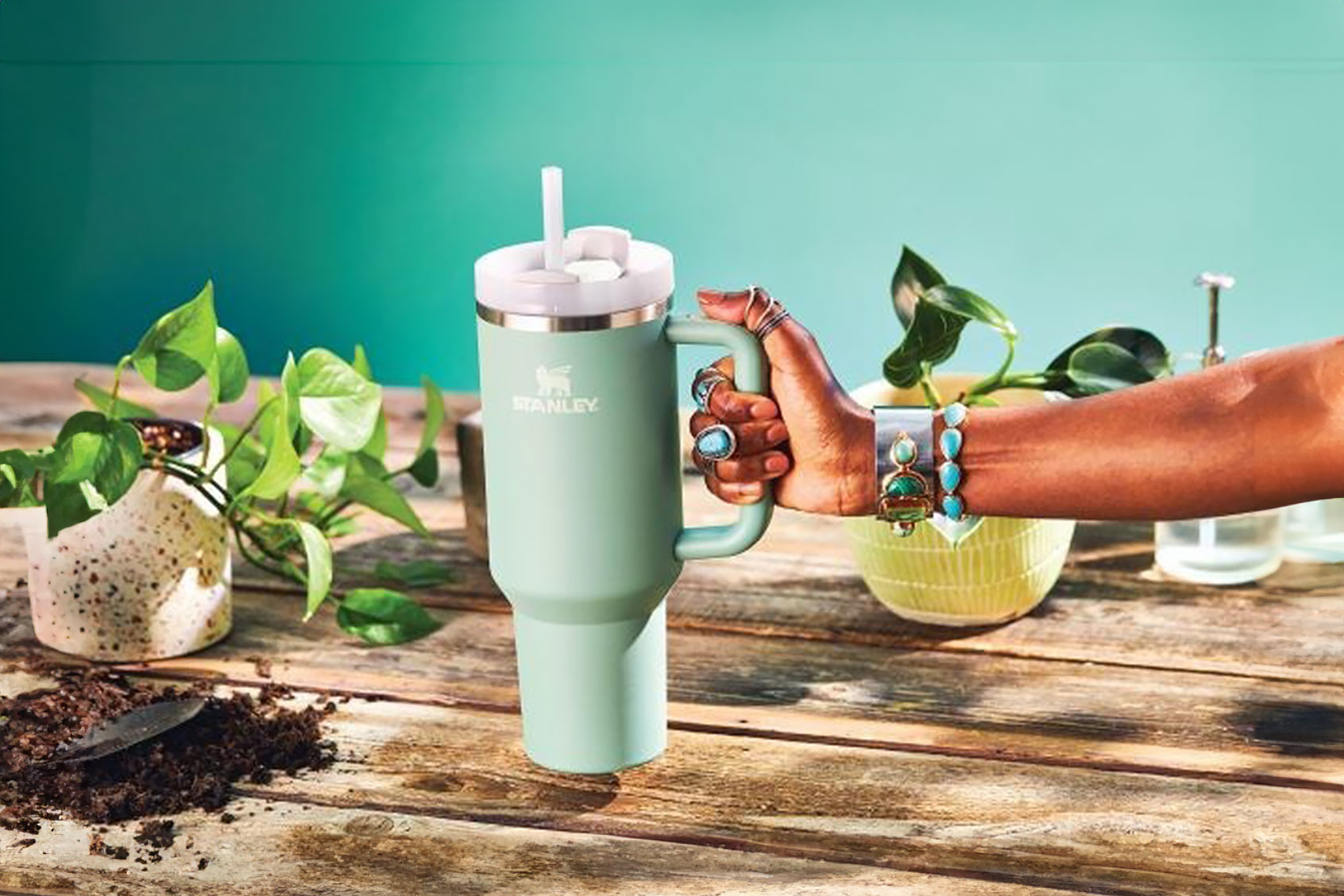Since developing the all-steel vacuum flask in 1913, the Stanley company has cultivated a particularly rugged, if not decidedly masculine, image. Per a 2012 release from the company, which was originally founded by William Stanley Jr., an American physicist born in Brooklyn, their thermoses appeal to “a 30-year-career veteran policeman” and “a retired Army soldier” just as much as they did to the B-17 pilots who used them during World War II.
There are reports that Stanley bottles have been used by ranchers to collect and transport bull semen, by members of Everest expeditions to keep tea warm, and by medical professionals who needed a portable, temperature-controlled option for delivering human organs in times of crises. If we’re dealing in clichés, these thermoses belong in the lunchbox of a guy taking a break from the assembly line or in the hands of a construction worker.
Perhaps this is why it’s all the more fascinating that the Stanley bottles’ sister product, a pastel 40-ounce tumbler, has become a social media darling among millennial and Gen Z women — and that it’s the marketing whiz behind Crocs who helped make it so.
In 2020, Stanley hired Terrence Reilly, the former chief marketing officer of Crocs, as their new president. This was four years after the company had debuted their “Stanley Cup” called the Quencher.
“I joined as president in 2020 after a fantastic experience at Crocs where I helped Andrew Rees turn Crocs around,” Reilly said in a Wednesday interview on Creator IQ’s “Earned” podcast. “I like to think I had a hand in reshaping the brand, and that had granted me the opportunity to become president of Stanley in 2020. And we were a $70 million brand that appealed to guys with a green bottle that was 107 years old, and is one of the greatest products in history.”
He continued: “It's an iconic brand, iconic product, but there was a big opportunity to reposition the brand and appeal to new consumers, and that's just what we set out to do in 2020.”
One of the key changes to the company under Reilly’s leadership is that they began focusing marketing efforts towards reaching women, especially younger women. (If you take a look at the Stanley Brand Instagram, this is already apparent, as the grid features more and more photos of their brightly colored tumblers in the manicured hands of women baking, paddle boating and heading to the pumpkin patch— a real departure from war-time trenches).
The company partnered with Linley Hutchinson, Ashlee LeSueur and Taylor Cannon — the founders of The Buy Guide, an online shopping blog, who were early supporters of the brand. As Caroline Jansen of RetailDive reported in November, Stanley leadership flew the three women out to Colorado where they were attending the Outdoor Retailer conference.
We need your help to stay independent
“We can show them what it would look like if women could market it to women,” LeSueur told the publication. “Stanley had been a company only producing occasional-use items. They were making items for people’s camping trips or tailgating. We told them that this cup was a daily-use item. It was an everyday, all-day item. And that it needed to look good in people’s homes and kitchens, with their outfits, and not just in the great outdoors.”
According to LaSueur, brands that elect to ignore 25- to 50-year-old women in their marketing are thinking too small.
“Even if you are a men’s clothing line — no matter what you are — if you are not finding a way to speak to this 25-to-50-year-old female, you’re missing the mark because those are the buyers of our economy. They buy for their families, they buy for their husbands, they buy for their businesses,” LaSueur said.
The decision to broaden Stanley’s reach came at an opportune time.
We’ve reached “peak hydration culture,” as some media outlets have termed it. In her assessment, Salon’s Nicole Karlis spoke with medical experts about the trend towards lugging around jumbo-water bottles. Some of them are skeptical that bottle companies themselves are behind the recent push towards drinking more water (as one nephrologist pointedly told Karlis, “I might point out that the human species has done quite well without a 40 ounce bottle for a very long time”) but that hasn’t stopped customers from flocking to buy Hydro flasks, Starbucks cups, Hydro Jugs and now Stanleys in their pursuit to stay hydrated.
However, Stanley saw this cultural undercurrent and, with the insight of The Buy Guide team, upped the game by starting to expand the colors and patterns in which they offered the Quencher, focusing on seasonal releases and merch drops — it’s worth noting Crocs excelled at this strategy during Reilly’s tenure — thereby rendering the bottles collectible. Enough so that Stanley's annual sales rose from $75 million a year to $750 million a year in 2023.
The fervor behind these figures was vividly illustrated in December when Stanley released a special-edition cup, rendered in a delicate baby pink, in collaboration with Target and Starbucks. Social media was flooded with videos of lines of shivering, yet hopeful customers, mostly women, waiting for hours for participating locations to open. When the doors were finally unlocked, it was met with an almost Black Friday-like enthusiasm. There were reports of fights and tramplings and empty shelves within just a few minutes.
As with all things that become immensely popular, we’re starting to see some of the darker edges of commercial success: the loud dissenters, the counterfeits, the sometimes-sketchy resale market. However, Reilly remains optimistic about the next chapter of Stanley.
“The financial success and all that is great, we are a business, but it's magic that we have countless TikTok videos of fit checks saying ‘here's my Stanley’ before they're even talking about their fit,” Reilly said on “Earned.” “It's really a remarkable thing.”
Read more
about this topic

